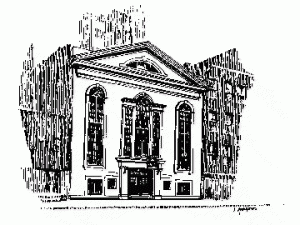Oldest Methodist Congregation in the United States

The story of the John Street Church actually begins in Ireland, where Philip Embury, his wife, Barbara Ruckle Heck (Embury’s cousin), and her husband were converted to Methodism. Philip Embury became one of Wesley’s local preachers.
In 1760, a number of Irish Methodists, including the Emburys and the Hecks, immigrated to New York City. Some of the group departed from Methodist ways, to Barbara Heck’s distress. She persuaded Philip Embury to begin preaching again, and in October 1766 he began holding regular services in his home.
The services soon outgrew the Embury home, and the Methodist Society began meeting in rented facilities, first on Barrack Street and then on Horse and Cart (now William) Street. The latter was called “The Old Rigging Loft” because the upper story was sometimes used to rig ship’s sails.
Philip Embury was soon joined in the pulpit by Captain Thomas Webb, a British officer (with lieutenant’s rank) and a licensed Methodist lay preacher. By 1768, the congregation had outgrown the rigging loft, and on March 30, 1768, two lots on nearby John Street were purchased. The first building erected on this site was called Wesley Chapel and was dedicated on October 30, 1768. It was the first permanent home of America’s oldest continuous congegation.
A trustee, Thomas Taylor, wrote John Wesley about the chapel’s construction and requested financial help and spiritual leadership. In response, Wesley sent the first two Methodist missionaries, Joseph Pilmore and Richard Boardman, to America. They were soon followed by others, most notably Francis Asbury.
The Hecks and Emburys left New York City in 1770, but the work at John Street continued. Francis Asbury preached there numerous times, and early General Conferences held their sessions in the chapel.
A slave named Peter Williams was one of many African American members of Philip Embury’s society. He became sexton of Wesley Chapel and, with James Varick and others, formed what later became the Methodist Episcopal Zion Church.
In 1817, the chapel was torn down to make way for a larger structure, dedicated in 1818. A third (and smaller) edifice was erected in 1841 and is still in use today.
Taken with permission from Heritage Landmarks: A Traveler’s Guide to the Most Sacred Places in The United Methodist Church, by the General Commission on Archives and History. For more information, see http://www.gcah.org/research/travelers-guide/john-street-united-methodist-church




